skip to main |
skip to sidebar
In 2018, the Battlefield Line 'Santa Special' trains between Shackerstone and Shenton were, once again, of two types, run alternately - the 'Classic' train with vestibule stock and the 'First Deluxe' train with corridor compartment stock. On the 'Classic' train, Santa's Helpers take groups of passengers, in turn, to see Santa Claus in his Grotto, where the children receive a Christmas present. On the 'First Deluxe' service, families or groups can book a private compartment with a Christmas Hamper of food, drink and Christmas Crackers and are visited by Santa distributing presents.
Events of Sunday 25th November 2018
The season started on Sunday, 25th November when just two 'Classic' services were operated at noon and 2.00 p.m. Visiting 'Pannier' 6412 was allocated. For both the lady fireman, Tracy, and the writer it was our first 'turn' on this engine. Whilst I'd worked on a number of Panniers (there's a post here with more information), I'd not not been on a '64XX' previously. The most obvious differences were the screw reverser, the absence of coil springs obstructing the cab (on the '64XX' the trailing coupled wheels have laminated springs) and the provision for working 'auto trains' (sadly, we wouldn't have an opportunity to use this facility but it had been used during the Battlefield Line Steam Gala 2018, described here).
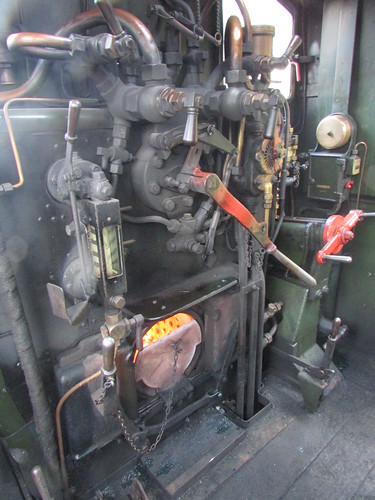
Battlefield Line Santa Trains 2018: Boiler backhead on 6412. Note the screw reverser and vertical control shafts for 'auto' working.
Preparation
A 'warming fire' had been put in the previous evening, leaving a 'few pounds of steam on the clock' when Tracy and I arrived. We discovered that our engine was equipped with a steeply-sloped rocking grate so Tracy set-to cleaning the fire and raising steam. I settled down to working out the simplest way of getting to the various oiling points. Most of the expansion link, crosshead oil boxes for glands and miscellaneous oiling points I could reach by lying flat on the footframing, first on one side, then the other.

Battlefield Line Santa Trains 2018: 6412 motion looking towards cylinders from right side showing slide bars and valve rods.
To attend to the big ends and eccentrics I had to 'go underneath' into the inspection pit, squeezing into the space between the frame stretcher just in front of the firebox and the cranks.
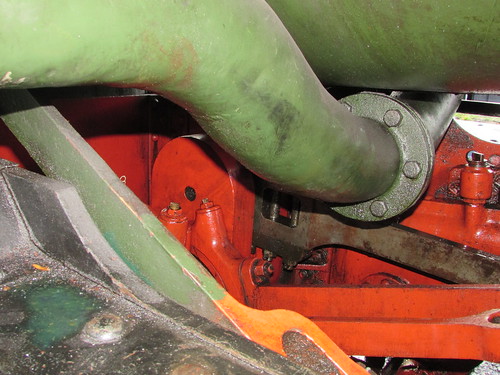
Battlefield Line Santa Trains 2018: 6412 motion looking towards firebox from right side showing LH Crank and Eccentrics. The large green pipe is the balance pipe between the oannier tanks. Note the steep angle of the (green) reversing rod connecting the reversing screw to the weighshaft which makes the cut-off indication scale very non-linear.
Each axlebox had two oiling points, closed with brass plugs, one feeding the reservoir at the top of the axlebox casting, the other feeding the underkeep. These are normally accessible when standing alongside the locomotive.
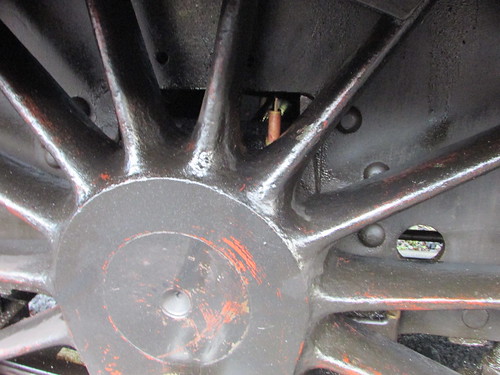
Battlefield Line Santa Trains 2018: Left Leading Coupled Wheel, with oil filler tube on top of Axlebox and filler for Underkeep just visible below the horizontal wheel spoke on the right.
All these oiling points use 'motion oil' (often around SAE220) but a compound oil (often called 'Steam Oil' with a viscosity around SAE680) which retains its properties at higher temperatures in contact with steam is used for the Sight Feed Lubricator which feeds the regulator, valves and cylinders. The Sight Feed Lubricator on 6412 is similar to that used a number of Great Western Locomotives which I've described in various earlier posts, for instance here (use the back button to return to this Santa post). I also added Steam Oil to the small oil pot in the steam line from the Brake Application Valve to the Steam Brake Cylinder to discourage the Brake Piston from sticking.
In common with 'standard' Great Western designs, 6412 has a Vacuum Brake Pump driven from the crosshead. A conventional oil pot with tail trimming lubricates the piston rod of the pump but there is also a special oil pot feeding the valves inside the pump body. These valves must open and close reliably on each stroke of the pump (giving rise to the characteristic 'phut-phut' sound when the engine is moving). A mixture of steam oil and paraffin is used for this task to minimise the possibility of valves 'sticking'. A ratio of 1:1 oil/paraffin is generally suitable but some old drivers put their faith in other ratios, derived from their experiences.

Battlefield Line Santa Trains 2018: 6412 motion, view looking left from right side with Expansion Links in the foreground and Vacuum Pump Body bolted to inside of left frame behind.
6412 on the 'Classic' trains
This was the first day of the 2018 'Santa' season and only the 'Classic' service was being run. We only had two trains to operate in the day, so we were hardly over-taxed. Runs to and from Shenton are deliberately leisurely, to allow our visitors to be conducted from the train to Santa's Grotto, housed in a 'BG' luggage van marshalled at the north end of the train. There's usually one stop at some point on the way to Shenton to allow Santa to see all the children. Shenton Bank, just before the end of the line is often used for the stop, as the location affords attractive views over the Leicestershire countryside on both sides of the train. At Shenton, the locomotive runs round its train ready for the return journey. On busier services, a stop may be required on the journey back to Shackerstone to give Santa time to see all the children.
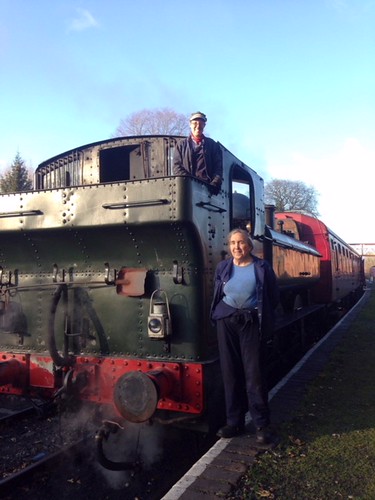
Tracy and Jan on 6412
Events of Sunday 9th December 2018
I was rostered on 6412 again. Sister engine 6430 had been hired in to operate the 'First Deluxe' trains. On the 9th, 6412 was to work three 'Classic' services and 6430 two 'First Deluxe' trains. Whilst we had two drivers (Dave H. was on 6430), we discovered we only had one fireman, Ritchie M., who cheerfully tackled lighting-up two 'Panniers'.
With Ritchie and I on the footplate, 6412 came off-shed first, around 9.00 a.m., to start steam heating the train prior to the first 'Classic' departure. Dave then looked after 6430 whilst we were down the line and, on our return, Ritchie joined 6430 for the second service, a 'First Deluxe'.
Arriving back in platform 2 at Shackerstone with a 5-coach train, the locomotive stops on the foot crossing at the north end of the platform, with the leading coach just clear of the crossing. This means passengers leaving the train have to wait for the locomotive to be uncoupled and draw forward before they can use the foot crossing to return to platform 1. Ritchie uncoupled before joining Dave on 6430, waiting to leave with the 'First Deluxe' from platform 1. Once I'd moved 6412 clear, passengers streamed over the crossing and shortly after 6430 left with the First Deluxe' train. The hand points were set towards platform 1 and, once the ground signal was 'off' and the foot crossing was clear, I followed the departed train through platform 1. At this stage, the signal protecting the crossover to the running line would normally be 'off' but it remained 'on' because the 'First Deluxe' had come to a stand with the last coach not yet clear of the crossover. So, I stopped at the adverse signal and waited to see what happened next.

Battlefield Line Santa Trains 2018: Departing 'First De Luxe' train unexpectedly stopped near the signal box.
After a few minutes, Graham L. came walking up the line from the station, carrying a vital piece of kit that had been inadvertently left behind by the catering staff. After Graham had delivered the missing item, the train set off and my signal cleared, allowing me to complete the run-round and arrange watering.

Battlefield Line Santa Trains 2018: Running round the 'Classic' train in platform 2. The lower disc signal is 'off', allowing 6412 to shunt onto the train.
Once re-united with the train, my task was to manage the boiler until 6430 returned with the 'First Deluxe' service.

Battlefield Line Santa Trains 2018: A rather thoughtful-looking Jan 'minding the shop' whilst waiting for Ritchie to return.
Once the 'First Deluxe' arrived back in platform 1, Ritchie swopped engines again and joined me for the third service, which was a 'Classic'.
The pattern was repeated for the fourth trip, a 'First Deluxe', leaving me once again looking after 6412, running-round, watering and hooking-on to the train (with a welcome bit of help).

Battlefield Line Santa Trains 2018: 6412 on the 5-coach 'Classic' train. Note the clinker shovel (or 'paddle') stowed on brackets on the rear of the coal bunker.
I then continued steam heating our coaches until 6430 returned after which, having completed his 'diagram' of two trips, Dave was able to put 6430 back on shed.
Finally, Ritchie and I made the final 'Classic' trip, rather late-running after the various problems during the day. Dusk came quite early so Ritchie lit our paraffin engine lamps and by the time we set off on our return trip, it was quite dark. I talk about operating on a railway after dark in the post The Railway at Night and there's a little about driving at night on the Battlefield Line here (use the back button to return to this Santa post).
Once we arrived back at Shackerstone, all our happy passengers left us and Ritchie and I were able to dispose of 6412, after a rather heavier day than anticipated for all the footplate crew, particularly Ritchie.
Events of Saturday 22nd December 2018
My last driving turn at Shackerstone in 2018 was on the final Saturday before Christmas. with Jamie firing. We were on 'Pannier' 6412, with 'Classic' departures at 09:45, 13:00 and 16:30. The other 'Pannier', 6430, crewed by Carl and Craig, operated two 'First Deluxe' departures at 11:30 and 14:30. Once again, it was dark by the time we'd finished our last trip (with the temperature dropping sharply) but we were better able to keep to time.
Related posts on this website
All my Battlefield Line posts.
My photograph albums
Where necessary, clicking on an image above will display an 'uncropped' view or, alternately, pictures may be selected, viewed or downloaded, in various sizes, from the albums listed:-
Battlefield Line 'Santa' trains 2018.
All my Battlefield Line pictures.
Santa Specials at Peak Rail in December 2018 followed the established format of a top-and-tailed service between Rowsley and Matlock Town, stopping at Darley Dale for operational purposes.
The previous Christmas, in December 2017, we had used saddle tank 'Ring Haw' (there's a post here with a link to pictures) but in 2018 we used the popular 'Austerity' 0-6-0T saddle tank No. 72 which has operated the services throughout 2018. Diesel-electric stalwart 'Penyghent' was used as the second locomotive in both years, marshalled at the north end of the train.
A persistent seasonal infection meant that I had to cancel a 'Santa Special' turn earlier in December but I carried out my turn on Wednesday, 19th December with Harvey C. as fireman. Fortunately, the weather was fairly kind.
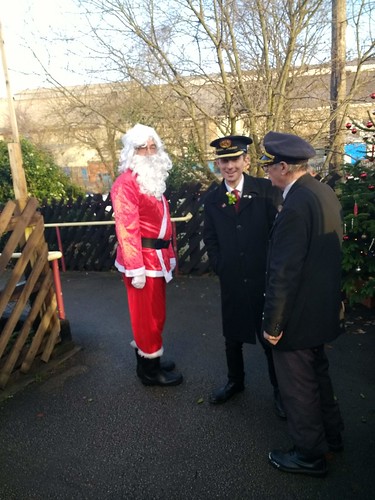
Peak Rail Santa Trains 2018: Santa on the platform at Rowsley ready to greet arriving passengers.
We ran four round trips leaving Rowsley at 10:45, 12:18, 13:51 and 15:24 with a seven coach train (plus the trailing load of 'Pehyghent).

Peak Rail Santa Trains 2018 No. 72 being watered at Rowsley.
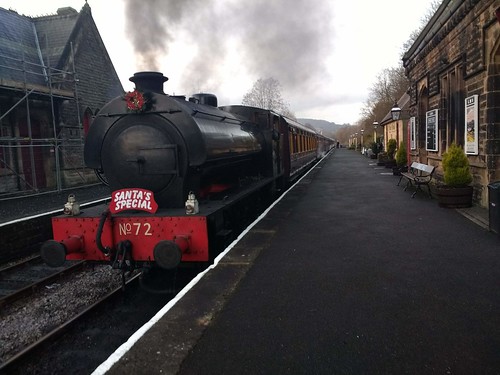
Peak Rail Santa Trains 2018: No. 72 (with Christmas wreath on smokebox) pauses at Darley Dale.
The final train was particularly interesting as we conveyed a Mayoral Party with their guests.

Peak Rail Santa Trains 2018: Mayoral Party about to board.
My photograph albums
Where necessary, clicking on an image above will display an 'uncropped' view or, alternately, pictures may be selected, viewed or downloaded, in various sizes, from the albums listed:-
Peak Rail Santa Trains 2018.
All my Peak Rail pictures.
A late arrival in Baku, Azerbaijan's capital, the previous day (described here) meant that our programme became compressed. We had managed to carry out the planned walking tour of Baku the previous evening (described here) but the day described below, the last day of my trip with Golden Eagle, was equally stimulating.
Friday 28th September 2018
Buffet breakfast was available from 06.30 a.m. in the Four Seasons large Zafferano Restaurant. At nine o'clock we all met up in Reception to join our various coaches. We were to visit the Gobustan National Park to see the ancient rock art. Our coaches slowly extricated their way south out of the city and I realised that we were retracing our arrival route the previous afternoon when the double-track electrified main line appeared on our right. Our highway, the E119 remained on the seaward side of the railway. We passed the massive LafargeHolcim Cement Plant to our right and various industrial sites to our left.

Around Baku: LafargeHolcim Cement Plant Garadagh, viewed from E119 highway.
Periodically, we passed modern police stations. Our guide invited us to recall that the transition from Soviet state to independent nation in the last twenty five years has not been without difficulties and Azerbaijan experienced a repressive and lawless phase. He suggested that the large glazed areas in modern police stations were intended to send the message that the modern police have nothing to hide.

Around Baku: Local Police Station on the E119 Highway.
To reach the Gobustan National Park, now a World Heritage Site, our coach crossed over the railway line on a road bridge and climbed into the muddy-looking foothills I'd first seen the previous afternoon as we arrived at Baku by train. We parked in a car park already busy with cars and coaches. We deferred an exploration of the very modern Visitor Centre until later and our guide led us directly into the rocky area where it seemed that almost every near-vertical cliff has been embellished with primitive carvings depicting scenes from the lives of the prehistoric people who once lived there.

The Rock Carvings of Gobustan National Park, Azerbaijan: One of the footpaths leading through the rocky landscape.
Despite the simplicity of the artworks, I found them evocative and full of vigour. Most are believed to be between 5,000 and 20,000 years old.

The Rock Carvings of Gobustan National Park, Azerbaijan
I found the carvings of animals particularly interesting but I'm afraid my camera couldn't really do justice to what we we saw.

The Rock Carvings of Gobustan National Park: animal images.

The Rock Carvings of Gobustan National Park: more animal images.
We also saw a 'Gaval Dash' - a naturally-occurring stone which resonates when struck. The example was about three feet long and this type of stone has only been found in the area of Gobustan where I assume the unique geology has produced gaseous inclusions in the stone, giving a strange ringing sound when struck by a smaller stone.

The Rock Carvings of Gobustan National Park, 'Gaval Dash' musical stone viewed from above.
I enjoyed the park itself but the modern visitor centre was rather crowded so we shuffled past the interpretations of prehistoric life fairly quickly. Nearby, there was a representation of a prehistoric village, with a number of full-size mannequin and a series of straw-covered huts. I was amused to discover that one of these huts housed a modern tea vending machine.

The Rock Carvings of Gobustan National Park: An unexpected tea vending machine!
The elevated site offered good views of the Caspian Sea, and the profusion of offshore oil and gas platforms served as a reminder of Azerbaijan's modern history.

The Caspian Sea viewed from Gobustan National Park, Azerbaijan
Wikipedia has an article about Gobustan National Park here. There's also a rather frantic presentation about the site here which gives some idea of the area. I was rather disappointed that we didn't get to visit one of the mud volcanoes in the area but I suppose it tends to be a rather messy business. The mud is reputed to have medicinal qualities.
We clambered back aboard the buses and drove back to the E119 highway which lead us back towards Baku. In places, we were close to the shore of the Caspian Sea - a rather odd sight with a chain of offshore oil or gas platforms spread across the view, some complete with drilling rigs.

Around Baku, Azerbaijan: The Caspian Sea, with a chain of offshore oil or gas platforms.
We passed the entrance to the ambitious Khazar Islands project - a planned city to be built on around 40 artificial islands which lost funding following a fall in oil price and currently on hold. The artist's impressions on the Design Build Network site here are certainly striking.

By coach to Baku from Gobustan, Azerbaijan: Entrance to Khazar Island (project currently suspended).
As we approached the city, our guide pointed out a large, informal taxi rank adjacent to a roundabout where passengers negotiate with the waiting drivers.

Around Baku, Azerbaijan: Informal 'taxi rank'.
Passing an area called Shikh Beach, we passed the waiting jack-up offshore rigs moored at a long jetty I'd spotted from the train on our arrival the previous day.

Around Baku, Azerbaijan: Moored 'Jack-up' Drilling Rigs at Shikh Beach.
We turned right off the highway into the narrow streets of Bibiheybat, an old part of the city and our coaches gingerly descended the hill towards the shore of the Caspian Sea.

Bibiheybat, Baku, Azerbaijan
We stopped near Nar Sharab hotel and restaurant where we were shown into a large restaurant overlooking the Caspian. The sun shimmering on the water and the outdoor sun terrace looked very attractive and some of the guests commented that they would have liked the opportunity to get closer to the sea but the service in the air-conditioned restaurant was friendly and prompt, the Azeri set menu was good and they served some interesting local wines.

Lunch at Nar Sharab hotel and restaurant, Baku, Azerbaijan
As we finished lunch, we were invited to choose from a revised afternoon programme of free time in Baku, a visit to the Carpet Museum or a trip to the Ateshgah Zoroastrian Temple of Fire. I chose to improve my very limited knowledge of the Zoroastrians and was shepherded onto the appropriate coach.
Bibiheybat is on a promontory thrusting into the Caspian. Our restaurant had given us views to the south but, within a few minutes of setting off, we were heading west along the northern shore of the promontory in an area called South Bay which was an active, but rather neglected, area of docks. There were four fishing vessels and four larger vessels of about 5,000 tons DWT (either oil tankers or bulkers) laid-up but looking rather sorry. I counted four floating dry docks, of various sizes, apparently in regular use.

South Bay, Baku, Azerbaijan

Cargo ships laid-up in South Bay, Baku, Azerbaijan

Ocean-going tug undergoing repairs in the Floating Dry Dock 'Yusif Ibrahimov', South Bay, Baku, Azerbaijan
We passed the modern campus building of Baku Higher Oil School and then, as often occurs around Baku, we passed into a rather barren area populated only by a few 'nodding donkey' electrically-driven oil pumps, quietly extracting the source of Azerbaijan's wealth. These pump installations are more correctly called 'Pumpjacks' - there's a useful Wikipedia article here.

Pumpjacks around Baku, Azerbaijan
Equally suddenly, we were back in a modernised area with manicured lawns and the imposing Baki idman Sarayi Aquatic Palace.

Baki idman Sarayi Aquatic Palace, Baku, Azerbaijan
In keeping with any modern, capital city, Baku has equipped itself with a Contemporary Arts Centre. This is housed in one of a group of restored industrial buildings. The Yarat Centre has a website (in English) with more information here. The adjacent buildings appear to offer a variety of dining experiences.

The Yarat Contemporary Arts Centre housed in a restored former industrial building, Baku, Azerbaijan>
A little further on, a disused electricity generating station built in 1921 has been restored and re-purposed as the Heydar Aliyev Foundation's Stone Chronicle Museum (following the collapse of the Soviet Union in 1991 Heydar Aliyev was the third President of Independent Azerbaijan, succeeded on his death in 2003 by his son Ilham Aliyev who is the current President). As our coach sped by on the E119 highway, I little realised that behind the Stone Chronicle Museum, a Russian 'L' class 2-10-0 steam locomotive had been plinthed and cosmetically restored.

Former electricity generating station restored as the Stone Chronicle Museum, Baku, Azerbaijan. Note the disused electricity transmission towers.
We were now passing the waterfront Boulevard area with the 60 metre Ferris wheel called the Baku Eye and the not-quite-finished Caspian Waterfront Mall (there's an interesting article on the history of the Caspian Waterfront on the architect's website here).

L: Almost complete Caspian Waterfront, R: Baku Eye. Baku, Azerbaijan
We passed the Azerbaijan Carpet Museum, designed to resemble a huge rolled-up carpet, then 'Mini-Venice' and the Yacht Club on our right, leaving our hotel, the Four Seasons, on our left. The coach traversed Neftchilar Avenue before turning away from the shore to continue north-east on Heydar Aliyev Avenue, passing a variety of modern buildings, some still under construction.

Around Baku, Azerbaijan
The coach continued east along the broad Airport Road before turning off into another of the strange, desolate areas around Baku of bare earth with oil derricks, pumpjacks and small capacity pipelines.

More Pumpjacks around Baku, Azerbaijan
Then we were back in a normal, suburban area, crossing a single track railway at a level crossing on the Zigh Highway before turning south-east along Balandin which took us past Surakhani station and into the coach park of the Ateshgah Zoroastrian Temple of Fire.
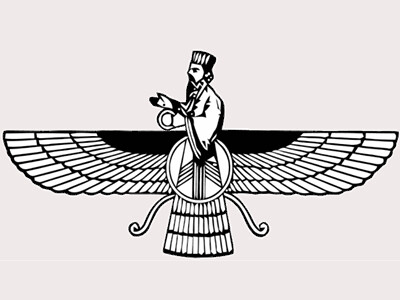
Zoroaster
Zoroaster was a Persian philosopher, prophet and spiritual leader who believed in two spiritual forces of Good and Evil with human free-will able to choose which to follow. Optimistically, he believed in the ultimate triumph of Good. He is generally thought to have lived between 1,000 and 1,500 years before the birth of Christ but this is uncertain. His thinking gave rise to the religion of Zoroastrianism which became the dominant religion in Persia.
See Zoroaster (Wikipedia) and Zoroastrianism (Wikipedia) for more.
The five-sided temple at Ateshgah has the appearance of a stone fortress, with a series of rooms and cells built into the thickness of the walls and a single access gateway, as shown in the plan below.

Plan of Ateshgah Zoroastrian Temple, Baku

Ateshgah Zoroastrian Temple, Baku: View of inner courtyard with five doors to cells in outer wall and access gateway on right
Fire was an important symbol in Zoroastrianism and the main altar always had an 'eternal flame'. Until recently, the 'eternal flame' on the main altar at Baku was fed by a natural escape of gas but increased gas extraction rates commercially in the area resulted in connection to the gas main!

Ateshgah Zoroastrian Temple, Baku: Central altar and 'eternal flame'
Although believed to have been built during the 17th and 18th centuries for Zoroastrians, the site also became a place of worship for Hindus. The Temple of Fire is now arranged as a museum with interesting displays illustrating the life of ascetic pilgrims.

Ateshgah Zoroastrian Temple, Baku: Pilgrims' cell.

Ateshgah Zoroastrian Temple, Baku: Stable for pilgrims' horses.
See also Fire Temple of Baku (atlas obscura).
After this very worthwhile visit, it was 'back on the bus' and retrace our route to the Four Seasons Hotel in Baku, pausing briefly to admire the flowing architecture of the Zahar Hadid designed Heydar Aliyev Centre. There's more on this building on Wikipedia here.

Heydar Aliyev Centre, Baku, Azerbaijan.
My 'Golden Eagle' trip was almost over - just dinner then bed because I had a very early start the following day. Dinner had been arranged for the whole party in the Mughab Club Restaurant, a few hundred yards walk from the hotel. We ate at two long tables, caravanserai-style with traditional musical entertainment provided. The meal was enjoyable but those of us with early departures the following day were happy enough to make our way over the cobblestones of the lanes leading us back to the main road, the hotel and bed after a packed day of excursions in Baku.
Related posts on this website
This is the last one of a series of posts describing my 'Golden Eagle' Caspian Odyssey trip, starting with Travelling East.
Alternately, clicking on the 'All my Caspian Odyssey reports' link displays all the posts on this trip in reverse date-of-posting order.
All my Caspian Odyssey reports.
On leaving Baku by air, I flew to Istanbul for a weekend. Clicking on the 'Next report' link below displays my first post describing Istanbul.
Next report.
My pictures
These albums include more pictures of the events described above:-
Four Seasons Hotel, Baku, Azerbaijan.
Around Baku, Azerbaijan.
The Rock Carvings of Gobustan National Park, Azerbaijan.
Ateshgah Zoroastrian Temple, Baku.
All my pictures taken in Azerbaijan (except 'technical' railway pictures) are in the collection Azerbaijan.
Although the double-track Liverpool & Manchester Railway initially adopted a 'Time Interval' system between trains which were only allowed to travel in one direction on each line, over time the deficiencies of this system had to be addressed, because of the risk of a following train running into the rear of an unexpectedly-halted previous train.
Train Staff Working
But single-line railways needed a different approach from the start as there was not only the danger of one train catching up with another but the possibility of trains travelling in opposite directions meeting head-on. The Americans have an evocative phrase for this event - 'cornfield meet'. In the U.K. the system of a 'Train Staff' was adopted. This was often a rounded length of wood (hence the name 'staff'). There was only one Train Staff for each single line section, marked with the section of line to which it applied. Before entering a single line, the driver took possession of the unique Train Staff and was thus assured that no other train was occupying the section. On clearing the single line, the driver would surrender the staff, allowing another train to enter the single line. Provided drivers were in possession of the the Train Staff when on the Single Line, this simple system was safe.
To increase the capacity of the line, a long single line was often divided into separate sections by intermediate stations provided with passing loops. There was only one Train Staff for each single line section between passing loops, marked with the names of the two stations between which it applied. Again, provided the footplate crew made certain they were carrying the correct staff for the section, the system remained safe. Train Staffs could be distinctively painted or shaped to assist the driver and fireman in identifying the correct staff but enginemen were also expected to read the names of the stations marked on the staff as a cross check. When I was a trainee fireman in preservation, I was taught to collect the Train Staff from the Signalman (or person in charge), check the details, shout "Correct Staff!" then display it to my Driver so that he could independently satisfy himself that we had proper authority to enter the single line section.

Simoonga - Livingstone single line staff (and two-way train crew radio), Victoria Falls Steam Railway, Zambia.
A bigger problem with this simple system was its inflexibility. If trains alternated in direction on the single line, the first train carried the staff from station A to station B, the second train, in the opposite direction, returned it from station B to station A. But there was no way for a second train from A to B to follow the first whilst the Staff remained at station B. There are tales of junior porters having to carry the Staff to the opposite end of the single line by bicycle in exceptional circumstances.
Train Staff and Ticket Working
Train Staff and Ticket Working seeks to address the inflexibility of ordinary Train Staff Working. The signalman or Person in Charge at station A must be in possession of the Train Staff before allowing a train into the single line section.
If a second train will run in the opposite direction, the Train Staff is actually CARRIED by the driver of the first train so as to be available for the second train on arrival at station B.
If a second train will follow the first in the same direction, the driver of the first train must be SHOWN the Staff. Seeing the Staff gives assurance that another train has not entered the opposite end of the section. The signalman also issues a numbered paper Ticket to the driver, identifying the specific train and giving authority to pass through the single line. When the train arrives at station B, the ticket is surrendered to the Signalman or Person in Charge there who cancels the Ticket. Because the Train Staff is still at station A, a second train may follow, this time with the driver CARRYING the Staff (unless a further Ticket is issued because of a third train in the same direction).
With Staff and Ticket working, telephone communication between the Signalmen or Persons in Charge at either end of the single line is essential because a further Ticket must not be issued until any previous Ticket had been correctly received and cancelled. Before allowing a train onto the single line, the Signalmen or Persons in Charge at both ends must agree upon the direction of the NEXT train required to pass over the single line. Whether a driver receives the Staff or is shown the Staff and receives a Ticket depends upon the direction of the NEXT train through the section. If the next working is in the opposite direction, the Staff is carried to the other end so it can be given or shown to that train. If the next working is in the same direction, the driver is shown the Staff (so that it can be shown to or carried by the following train) and CARRIES the Ticket. Tickets are valid for one specific train and, after a single use, are cancelled by the Signalman or Person in Charge receiving the used ticket.
Electric Token Working
Single-line control eventually benefited from the use of electrical interlocking from one end of a single line section to the other, allowing multiple single line tokens to be housed in machines at either end of each single line but ensuring that only one token could be released at a time and that it had to be returned (to either machine) before a further token could be extracted (from either machine). This arrangement allows 'unbalanced' working of trains until either machine runs out of stored tokens. Numerous designs are in use in various parts of the world, including:-
Electric Key Token ('Lollipop' token).
Tablet (round, metal disk token).
Ball token (Neale's pattern as widely used in Thailand)
This very simple explanation clearly needs expanding in the future.
Interlinking with Signals
A feature of British signalling practice where a train staff is used is an electrical interlock to ensure that the appropriate staff is present in the signal box before the signal admitting a train to the single line (the 'section signal') can be 'cleared'. For instance, this safeguard is provided at Shackerstone on the Battlefield Line.

The Single Line Token at Shackerstone.
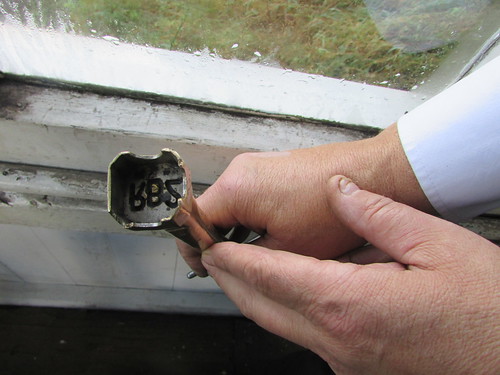
The Single Line Token, showing the incorporated 'Castell Key'.

The Release equipment in Shackerstone signal box for the 'Section Signal'.

Token inserted into Release equipment.
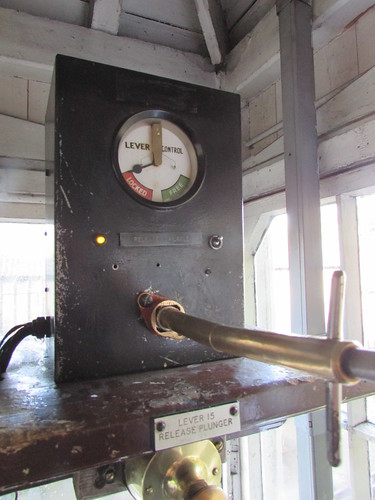
Token inserted into Release Control and turned. Yellow Lamp lit indicates the release is available to allow the 'section signal' to be 'cleared'.
Pilotman Working
If a train staff is lost or damaged or electric token equipment fails, subject to suitable safeguards, trains may continue to run using a 'human agent' as a Pilotman. He identifies himself to all staff by wearing a special armband marked 'PILOTMAN' (or, in exceptional circumstances, an armband made from a red flag).
Related articles on other sites
Token (railway signalling) Wikipedia.
Indian Railways single line instruments The Signal Box.




















































